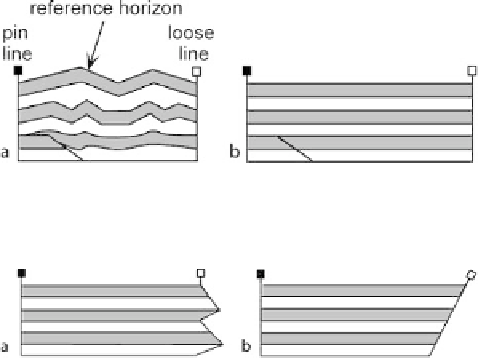Geology Reference
In-Depth Information
11.6.1
Restoration
Flexural-slip restoration consists of measuring bed lengths and straightening the lengths
while preserving the thicknesses to produce the restored section. The section to be
restored is bounded on one end by a pin line and on the other by a loose line (Fig. 11.29).
The pin line is a straight line on the deformed-state cross section that is required to
remain straight and perpendicular to bedding on the restored section. The loose line
is a straight line on the deformed-state section that may assume any configuration on
the restored section, as required by the restoration. For the sake of clarity, pin lines are
shown here as having solid heads and loose lines as having open heads.
A loose line that is straight and parallel to the pin line is the best indication of a valid
restoration (Fig. 11.29b). Faults on the deformed-state cross section are shown in their
restored positions on the restored section (Fig. 11.29b). The reasonableness of the re-
stored shape of the fault is another criterion for the quality of the restoration. Note that
the lengths of lines oblique to bedding and the cutoff angles between bedding and
faults are changed by the deformation and so are different in the deformed-state and
restored cross sections. A loose line that is highly irregular is the clearest indication of
a section that is not valid (Fig. 11.30a). A straight but inclined loose line (Fig. 11.30b)
indicates a systematic length difference that may represent an invalid cross section, a
poor choice of the pin line or the loose line, or material introduced or removed by
layer-parallel simple shear. Usually at least four to five beds must be tested to deter-
mine whether the section is correctly restorable or if some type of error is present.
In complex structures, the choice of pin line and loose line requires care. The goal
is to choose the pin line and loose line in locations that can be expected to restore to
perpendicular to bedding and consequently to have constant bed lengths between them.
There are a number of possible choices. The best location for a pin line and loose line
Fig. 11.29.
Cross-section restoration.
Pin line
, solid-head;
loose line
, open-head.
a
Deformed-state cross sec-
tion.
b
Restored section: equal bed lengths and a
straight loose line
indicate a satisfactory restoration
Fig. 11.30.
Imperfect restorations.
a
Irregular loose line
indicates an invalid section.
b
Systematic error:
the
linear loose line
may indicate an invalid section or a poor choice of pin line or loose line

